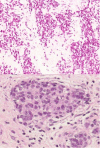Thymic Carcinoma Associated with Cerebellar Degeneration
- PMID: 30756016
- PMCID: PMC6346953
- DOI: 10.12890/2018_000780
Thymic Carcinoma Associated with Cerebellar Degeneration
Abstract
We present the case of a 57-year-old man with ataxia and clinical and radiological features of cerebellar degeneration. Computed tomography showed a mediastinal mass and the patient was diagnosed with thymic carcinoma. Paraneoplastic cerebellar degeneration is aninfrequent disorder and its association with thymic carcinoma very rare.
Learning points: Unexplained subacute neurological symptoms in an adult patient should beconsidered in the possibility of a paraneoplastic syndrome. In patients over 50 years of age, acute or subacute cerebellar degeneration is paraneoplastic in 50% of cases.Small-cell lung cancer is the most common cancer-causing paraneoplastic cerebellar degeneration (PCD). Despite this, mediastinal tumours such as thymus neoplasms should not be ruled out in the differential diagnosis.Antineuronal antibodies are not detected in 40% of patients with PCD, sothe exclusion of other aetiologies or the demonstration of cancer formsthe basis of the final diagnosis.
Keywords: Thymic carcinoma; cerebellar degeneration; paraneoplastic syndrome.
Conflict of interest statement
Conflicts of Interests: The Authors declare that there are no competing interests.
Figures
References
-
- Greene MA, Malias MA. Aggressive multimodality treatment of invasive thymic carcinoma. J Thorac Cardiovasc Surg. 2003;125:434–36. - PubMed
-
- Girard N, Ruffini E, Marx A, Faivre-Finn C, Peters S on behalf of the ESMO GuidelinesCommittee. Thymic epithelial tumours: ESMO Clinical Practice Guidelines for diagnosis, treatment and follow-up. Ann Oncol. 2015;26(Suppl 5):v40–v55. - PubMed
-
- Klein JP, Stover DG, Oxnard GR, Levy BD, Loscalzo J. Restoring balance: paraneoplastic cerebellar degeneration. Am J Med. 2017;130:e85–e87. - PubMed
-
- Yamaguchi Y, Wada M, Tanji H, Kurokawa K, Kawanami T, Ohtake H, et al. Marked improvement in opsoclonus and cerebellar ataxia after the surgical removal of a squamous cell carcinoma of the thymus: a case report. J Neurol Sci. 2013;325:156–59. - PubMed
LinkOut - more resources
Full Text Sources


